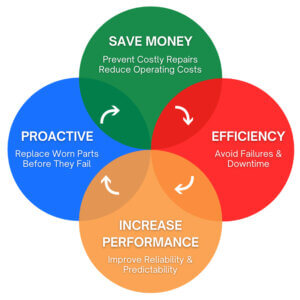NPE 2024 The Plastics Show – Orlando, FL
May 6-10, 2024
Booth S30177

This philosophy is especially worthwhile for items that are critical to your business. Take a minute to think about your quality lab – are you up to date on maintenance and calibration? If you need to think about it, chances are you may have equipment that is working on borrowed time. This is a costly scenario that often leads to emergency situations, such as inoperative equipment or the last-minute need to update your calibration certificate to stay in compliance with quality metrics.
Being proactive with the regular maintenance of your testing instrumentation will pay dividends and reduce overall operating expenses. Delaying or avoiding regular maintenance can result in the following, costly scenarios:
If you choose to defer the costs of regular preventive maintenance, you could find yourself losing operational time, accuracy in testing results, and wasted product due to falling out of compliance. Remember to focus on the big picture. To keep your processes operating at peak efficiency, your critical assets need to be maintained regularly to ensure the longevity of your investment.
Exploring each of these hidden costs in depth we can start with reliability as there is a point where peak operation is compromised or reduced without proper maintenance. A regularly maintained machine can run as designed and provide accurate data that is required to enable quality labs to run continuously and seamlessly.
Operator safety is vital for efficient production lines and consistent test results. When the maintenance is forgone, there are more unknowns as to what may happen with the equipment in a quick-paced testing environment. A worn component may cause the instrument to operate erratically and create a safety hazard for the operator or damage to the instrument due to malfunction.
Once an instrument fails, the following scenario occurs:
No machine = No Testing
No Testing = No Metrics for Production
Quality systems have defined criteria in most laboratory settings. Those metrics are used to ensure that the products you produce are within specification. Instruments that are reporting inaccurate results will create delays or work stoppage, higher raw material consumption, and higher operating costs. By maintaining a regular calibration and maintenance schedule, these issues can often be eliminated.
Testing instrumentation is designed to operate for a long period of time when properly maintained. When neglected, the operable life of the instrument is reduced resulting in costly repairs or the need to purchase a new instrument.
Materials testing machines are precision instruments that are designed and manufactured to strict tolerances to ensure the highest degree of accuracy. The accuracy of these instruments will ensure that the products you manufacture are meeting your specifications and the expectations of your customers. Poor product quality will result in higher operating costs, reduced profitability, and lost customer confidence.
The investment today in the maintenance of your testing laboratory equipment will keep you ahead of the curve for quality processes.